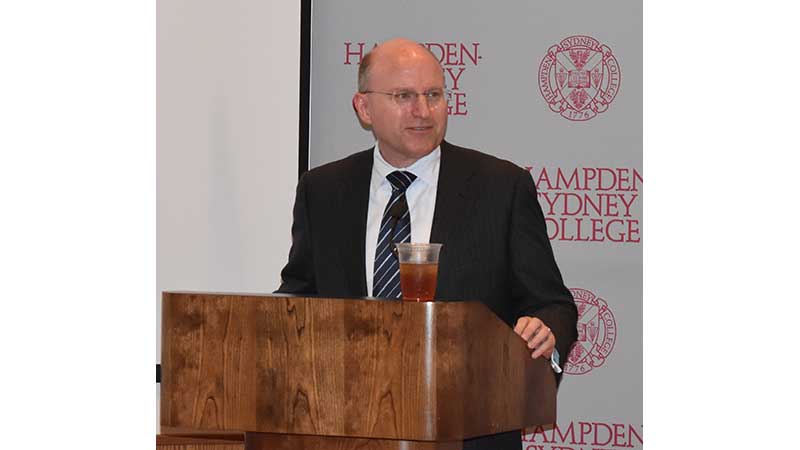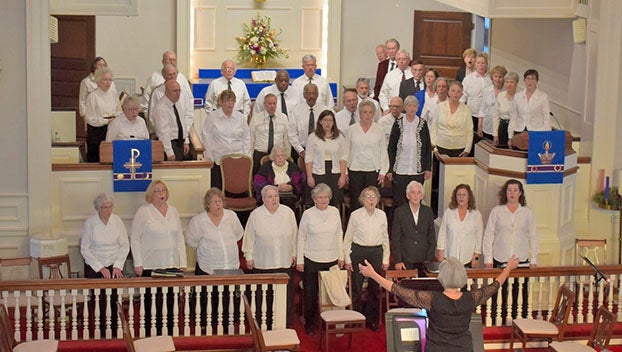Summit explores economic growth
Published 4:01 pm Monday, July 2, 2018

- Virginia Economic Development Partnership (VEDP) President and CEO, Stephen Moret, speaks about ways to enhance Virginia’s economic opportunities during a summit held by GO Virginia June 21. (Photo by Emily Hollingsworth)
Area business owners, organization representatives and partners for GO Virginia Region 3 discussed ways to jump-start the Heart of Virginia’s economic growth June 21 during a daylong conference, held in Hampden-Sydney College’s Crawley Forum.
GO Virginia, an initiative led by state-business owners, with support from the Virginia General Assembly and the Virginia Department of Housing and Community Development, provides grant funding to regional business initiatives that could generate economic strength to the Commonwealth.
GO Virginia’s Region 3 includes Prince Edward, Cumberland and Buckingham counties, also including Pittsylvania, Halifax, Henry, Patrick, Amelia, Brunswick, Charlotte, Lunenburg, Mecklenburg, Nottoway, and the cities of Danville and Martinsville.
“GO Virginia can only succeed if people like you understand its mission, the areas in which Region 3 council wants to invest, and begin to bubble up good project ideas,” Region 3 Chairman, Charles Majors said.
GO Virginia has $24.5 million in its budget, in addition to $15 million recently given by the state.
According to documentation from GO Virginia and Letterpress Communications, Region 3 is the largest district by land mass, having a total population of 371,700 and total employment of 153,265 with a 5.3 percent unemployment rate compared with the U.S unemployment rate of 4.1 percent.
“We want Region 3 to get our share, and to do that we need all of you to bring ideas to the table,” Majors said.
Speakers included Stephen Moret with Virginia Economic Development Partnership (VEDP); Davenport with GO Virginia and The Great Opportunities in Technology & Engineering Careers (GO-TEC) Project, a project that recently received funding through GO Virginia.
Moret said Virginia has a lot going for it, including it ranking in the top 10 for education attainment for higher education and K-12, having top ranking for public higher education institutes, Virginia’s proximity to Washington D.C., below average state/local tax burdens for existing firms and a wide range of federal labs and higher education research areas.
VEDP is an initiative created by the Virginia General Assembly in 1995 to support development and expansion of Virginia’s economy. While Virginia has positive economic factors, Moret said the Commonwealth is below what it needs to be to generate interest and growth from businesses looking to relocate.
He said the Commonwealth ranks low with state workforce development programs, not having a large pool of college graduates with information technology or data science experience, having a higher than average tax for new businesses, or businesses looking to expand, lack of four-lane roads in rural areas and not having prepared medium or large-scale sites for developers or companies looking to relocate.
Moret said one of the main issues is not that businesses don’t choose Virginia, but don’t know that Virginia is an option.
“While the strengths that we have are amazing, and wonderful, the weaknesses are also real, and these weaknesses have resulted in some significant, negative outcomes for the Commonwealth over the last several years,” Moret said. He noted that marketing, where funding had been cut in the last several years, received funding this year.
Moret said data from 2018, following sequestration shows Virginia 5-year growth ranking falling to 36th in total employment, 42nd in gross state product and 46th in median earned income.
“We actually have gone from net domestic population in-migration to net domestic population out-migration,” Moret said, noting more population moving out of Virginia than in. He said ways to address and create growth throughout the whole commonwealth are daunting but doable. To achieve the rankings it had prior to 2009, Virginia would need to create tens of thousands more jobs each year.
Other ways to achieve growth, Moret said, includes creating a workforce recruiting and training partnership with VEDP and state community colleges, increasing aggressive marketing toward large-scale businesses, expanding broadband access to businesses and residents and preparing sites geared toward medium to large-scale industries.
Davenport spoke about GO Virginia’s goal to rebuild the rural Virginia economy.
“We took a hit,” Davenport said. “A bad hit, but it’s not anything we can’t come out (of) and we can’t use as an opportunity.”
Davenport spoke about a partnership between GO Virginia and VEDP. Davenport said GO Virginia’s strengths include focus on regional development and funding, while VEDP’s strengths include business recruitment and workforce training with Virginia community colleges.
He said GO Virginia received a $15-million increase and established a $1 million floor per region, meaning that each region would be allocated per capita at minimum $1 million for funding. Region 3, which would have initially be allocated $612,652, would now be allocated $1 million.
Other projects GO Virginia are collaborating include creating a statewide internship initiative with State Council of Higher Education for Virginia and United Way, and potentially collaborating with universities to fund and establish research facilities with the Virginia Research Investment Committee.
He charged GO Virginia members and local leaders to take risks that could lead to economic growth for the state.
He said while real change is taking place, generating economic strength long term is a slow process.
“It’s easy for us to be critical of how it’s moving forward, it’s not moving forward at a real fast pace, I will tell you that it’s not something that will get fixed overnight,” Davenport said.
Dr. Bruce Scism, president of Danville Community College, spoke about phase one of the GO-TEC project, which recently received $648,000.
The goal of GO-TEC, according to the presentation, will “provide the resources necessary to increase the pipeline of skilled workers and extraordinary training capability in identified industry clusters through a collaboration with K-12, community college, and higher education centers throughout the region.”
Scism said the program will begin in middle schools, where students will be able to learn about trades. Scism said programs of focus will be precision machining, welding, IT/cyber security, robotics & automation and advanced materials. He said health sciences may also be added.
“If we wait until students are in high school, if we wait until they are in the 12th grade and then say, what do you want to be? It’s too late. So this is really going to drive it down to the middle school level.”
The next phase will focus on creating labs demonstrating and offering training for these fields into area middle schools.
Scism said GO-TEC would follow a hub and spoke systems. The hubs will be advanced manufacturing training centers, such as the Gene Haas Center for Integrated Machining in the Danville Institute for Advanced Learning and Research. The spoke would be area community colleges and high school level career and training center.
The initiative involves a partnership with several area community colleges, which includes Southside Virginia Community College, Danville Community College and Patrick Henry Community College among others that will take part in the program.
Phase Two is expected to include 11 additional public schools systems, including Prince Edward County Public Schools and Cumberland County Public Schools. Phase One currently has schools in Danville and Pittsylvania.
“Have the opportunity for all of these public schools, not just say ‘well, once in a while we will be able to access training,’ and you hope you remember everything when you go back to your schools,” Scism said. “So we want to have it set up where, at any time, they can come to a facility, or a trainer can be at their institution … so they can come for training and there is a support network.”
Angela Rigney, who oversees the Career and Technical Education (CTE) programs for Pittsylvania County Public Schools, said schools in the county are expected to bring the labs to middle schools in Pittsylvania and Danville this fall, which could include welding simulators, blood pressure simulators, industrial robots, equipment students would see at manufacturing plants or health field centers.
Rigney said the division’s CTE students perform well academically in other subjects, saying that some scores include 98-100 percent pass rates in English and mathematics. She said potentially exposing more students to CTE careers could help them find a subject they are passionate about, in addition to helping them perform better academically and giving them a clear map of what classes they need to take in the high school level.
“We find that when students are interested in something, they want to be there,” Rigney said.





